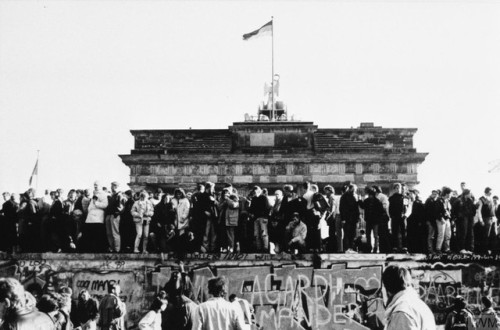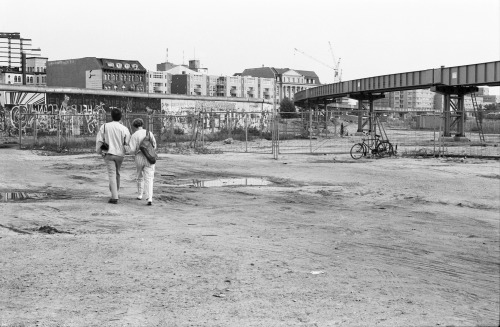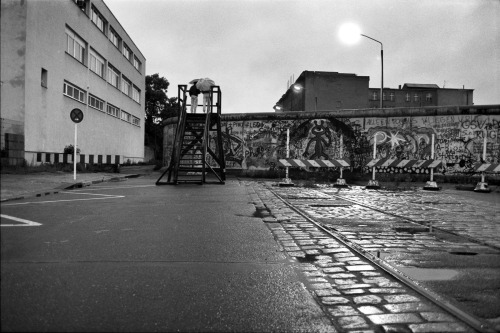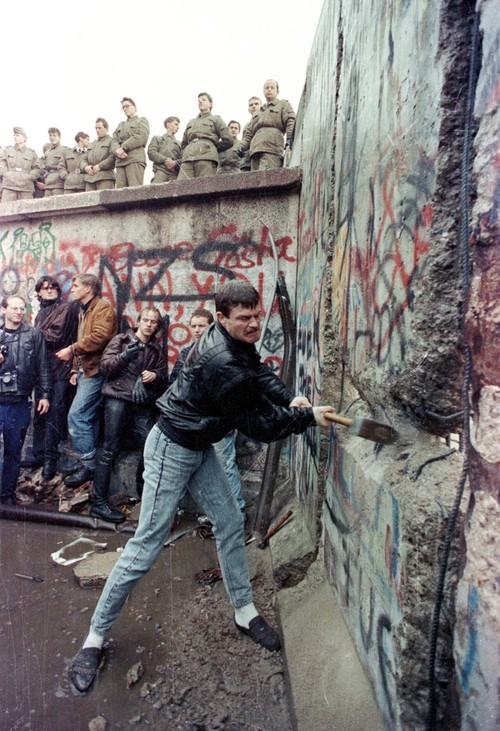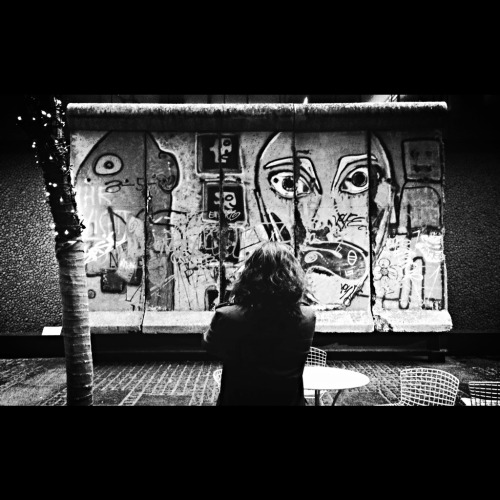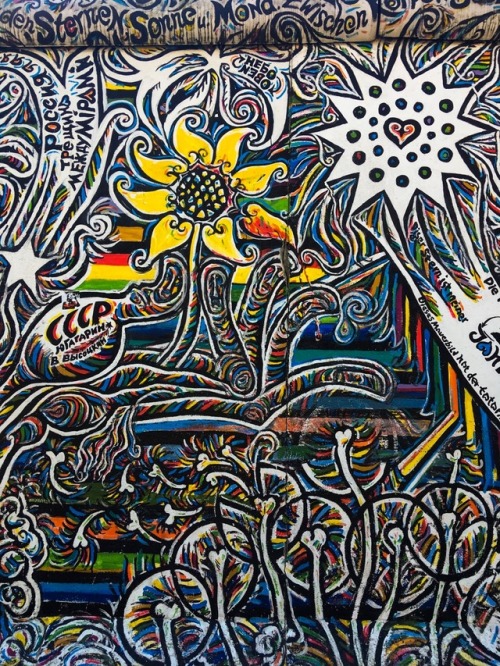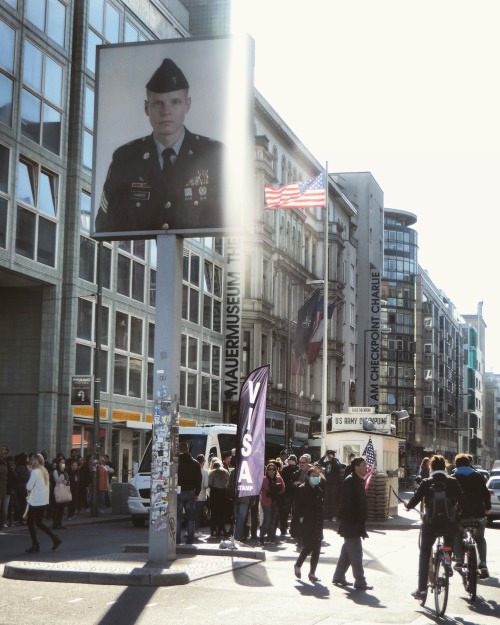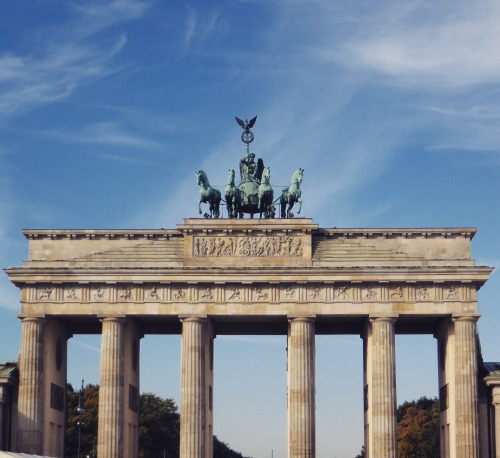#berlin wall
East and West Berlins celebrate the lifting of travel restrictions on East Germans on top of the Berlin Wall, in front of the Brandenburg Gate (1989).
Post link

i learned that when David Bowie died in 2016, the German government thanked him for a concert he held in Berlin in 1987, stating it was a major reason Berlin was unified and tore down the Berlin wall (x)
Potsdamer Platz August 1986. Köthenerstrasse visible beyond the monorail line (M-Bahn). All the buildings seen here are in West Berlin.
Post link
West Berlin Bernauer Strasse 1986. The memorial to Olga Segler, who died at this spot trying to escape to the West.
Post link
In 1946, a Light Street block party was held to celebrate the one-year anniversary of V-J Day, the day after Japan agreed to surrender during World War II. The block was decorated with American flags, multicolored pennants and lights, and featured live music. (Baltimore Sun file photo, 1946)
1914: The Panama Canal was opened to traffic.
1918: The United States and Russia severed diplomatic relations.
1939: The MGM film musical “The Wizard of Oz” premiered at the Grauman’s Chinese Theater in Hollywood.
1961: East German workers began building the Berlin Wall.
Compiled by Jessica D. Evans and Paul McCardell.
Fall of the Berlin Wall in 1989 - today is Tag der Deutschen Einheit (Day of German Unity or German Reunification Day). It’s Germany’s national day, celebrated annually on 3 October as a public holiday. It commemorates the anniversary of the German Reunification, which was formally completed in 1990, when the goal of a united Germany that originated in the middle of the 19th century, was fulfilled again. The name thus addresses neither the re-union nor the union, but the unity of Germany.
Post link
Today’s Google doodle celebrates the falling of the Berlin wall. The East Germans may have had it bad however it doesn’t even make a blip on the radar compared to the oppression the Palestinians endure. The Berlin wall was 106km long and 3.6m high, the West Bank barrier is currently 438km and 8m high and on completion will be 700km long.
I hope to see this wall come down in my lifetime.
A young man sits atop the Berlin Wall and howls for joy as the hated symbol of the division of Europe between east and west is finally rendered redundant.
Photograph: Raymond Depardon/Magnum
Post link
London and Berlin
by Gwen Lindberg
The sixteen sophomores in the 2017 Fall Europe 1 Program began their academic year by spending seven days in London and ten days in Berlin. In a class studying European Politics, taught by Rainer Braun, we spent our mornings in three-hour self-directed lectures based on readings assigned the night before. Our afternoons were spent on experiential education excursions (okay, field trips), where we explored historic and famous locations, museums, and monuments across the two cities. Our evenings were spent wandering the cities on our own, finding little jewels and eating an enormous amount of delicious food. (If you happen to find yourself in London with a free afternoon, try to find one of the culture containers spread across the city; I particularly recommend the one called Artworks Elephant at the tube station Elephant and Castle. They are little shipping crate container areas that have been taken over and transformed into little ethnic restaurants. If you’re looking for places to eat in Berlin, take the train to Rosenthaler Platz; you will find a huge selection of restaurants with food that ranges from schnitzel and spaetzle to kimchi and kebabs, with special 24-hour homemade pasta places.)
If you haven’t already guessed, this year’s sophomore class is entire, completely, irrevocably food-motivated. Ask us if we are interested in going somewhere, and you’ll probably get a mixed response. Tell us there will be a snack…and every single person will show up. We eat good while talking about other food, while thinking about more food. What a wonderful way to live.
Our lectures in London primarily focused on the concept of the state and the creation of modern nation-states. We studied the interaction between nationalism and the state and its effect on governance. We visited Buckingham Palace, and as exciting as seeing a secret passage behind a mirror was, we were all rather disappointed we didn’t get a glimpse of either the Queen or her corgis. We toured the house of the EU Parliament and learned of some of the rules that give British politics a rather stuffy reputation. Our day at the UK House for the Representatives to the EU was spent understanding the ramifications of Brexit and the public’s dissatisfaction with the way in which information was provided before the vote. Thursday included a visit to the Black Cultural Archives, where we had the opportunity to study authentic newspaper clippings from the civil rights movements across the UK. Though our original plans to tour a mosque on that Friday fell through, we did have the chance to view an exhibition of Islamic Feminism, with small yet incredibly powerful displays designed to elicit personal responses from each viewer.
Berlin was spent focusing on the interactions between nation-states and how the formations of such relations continue to echo post-war sentiments to this day. Our visit to the Topography of Terror on our first day in Berlin set the stage for us to focus on historical contexts mirrored in today’s political climate. We visited Checkpoint Charlie, and we were captivated by a collection of personal photographs from the fall of the Berlin Wall on November 9, 1989, and an interactive, panoramic display of the wall just before its fall. The exhibit made history a tangible thing, something we could see and hear and almost touch. We also visited the German National Museum, the Memorial to the Murdered Jews of Europe, the Memorial to Persecuted Homosexuals Under Nazism, and the Memorial to the Sinti and Roma Victims of National Socialism. Each memorial elicited a different response; the abstract blocks of the first brought unexpected emotions to the front for many of us, while others were more affected by the interactive aspect of the Homosexual Memorial or the calm pool and engraved stones of the Sinti and Roma Memorial.
Our visit to the Sachsenhausen Concentration Camp was powerful and thought-provoking for all of us, regardless of whether or not this was our first visit to a camp. The usage of concentration camps in the post-WWII era was a new concept for many of us, and it was equally fascinating to see the monument set up in the middle of the camp honoring only the communist prisoners in the Soviet era.
Our class agreed in unison that the most interesting afternoon excursion was the walking tour we had early on, led by a Syrian refugee, who tied post-WWI and -WWII events to the current violence in Syria. The connections made during this tour were something that never would have occurred to me on my own, and it has inspired me to look more deeply into the interconnectedness of history.
The first two weeks of the semester flew by as we reconnected with classmates and rekindled our spirit of passion and adventure for the upcoming semester in Spain.
Post link

When we think about the Berlin Wall, despite having an idea of how its length, we can’t easily envisage its real size. With this question in my mind, I decided to create a computer generated 3D model of the wall compiled together in a single frame.
I started by conducting some research on Wikipedia:
“The “fourth-generation wall” (Grenzmauer 75) , known officially as “Stützwandelement UL 12.11″ , was the final and most sophisticated version of the Berlin Wall. Begun in 1975 and completed about 1980,it was constructed from 45.000 separate sections of reinforced concrete, each 3.6 metres high and 1.2 metres wide. The concrete provisions added to this version of the Wall were done so as to prevent escapees from driving their cars through the barricades (“L” shape structure).The top of the wall was lined with a smooth pipe, intended to make it more difficult to scale. This version of the Wall is the one most commonly seen in photographs, and surviving fragments of the Wall in Berlin and elsewhere around the world are generally pieces of the fourth-generation Wall.“
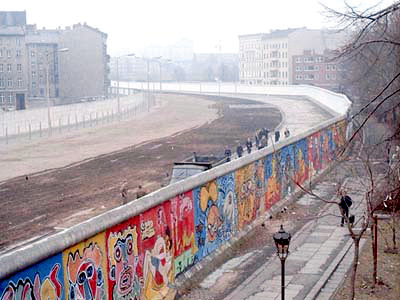
The next step was to make a 3D model of a single segment from its blueprint and then duplicate it 45 thousand times. At that point I needed to decide how to compose all the pieces, so I ended up placing them together in the same proportions all from of a single segment. Doing this ensured that we are able to see both the shape of a single segment, on a larger scale, with more detail and the entire quantity that makes up the wall (exactly 45K pieces) together.
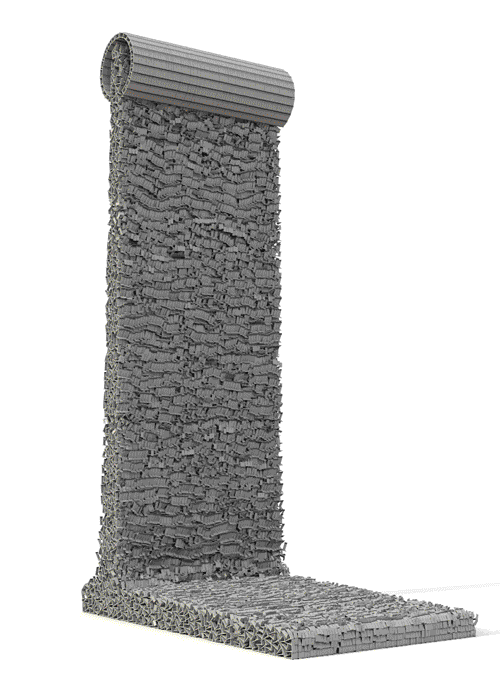
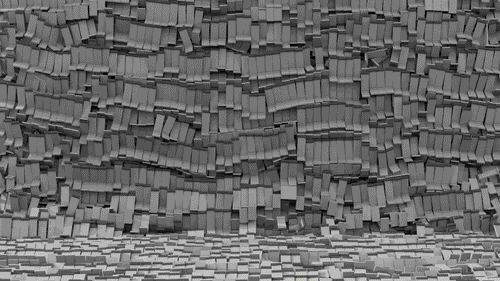
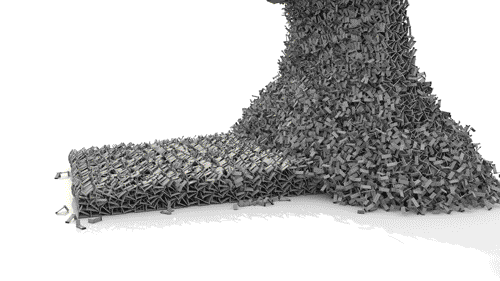

To envisage the actual size of the wall, the colossal structure (240 metres high) was placed in Alexanderplatz in true scale.

Photograph Copyright : © F1online digitale Bildagentur GmbH


Another step of the project is to have a 3D printed version of this fractal design in 1:1 scale (3,6 meters). So the viewer can easily recognise its form from a distance and upon closer inspection the wall can be viewed in its entirety. I am in search of commissions or sponsors to have it printed. Please contact me if you are interested.

To demonstrate the 3D printed structure in real scale, it was virtually inserted next to original wall segments at Berlin Wall Gallery of Newseum in Washington, D.C. Photo Credit: Sam Kittner/Newseum
In this animation you see the whole fractal structure (exactly 45.000 segments) with a collapsing simulation. The original full length animation piece is available in 5+1 editions and FullHD resolution.
Please check my site for more info! >>> erdalinci.com
Carmen Sandiego steals the Berlin Wall.
I hope you all went out and voted today for the party of your choice the most important thing to remember during elections is your right to democracy. Your vote counts no matter what constituency you’re in!

~Many small places do many small things that can alter the face of the world~

